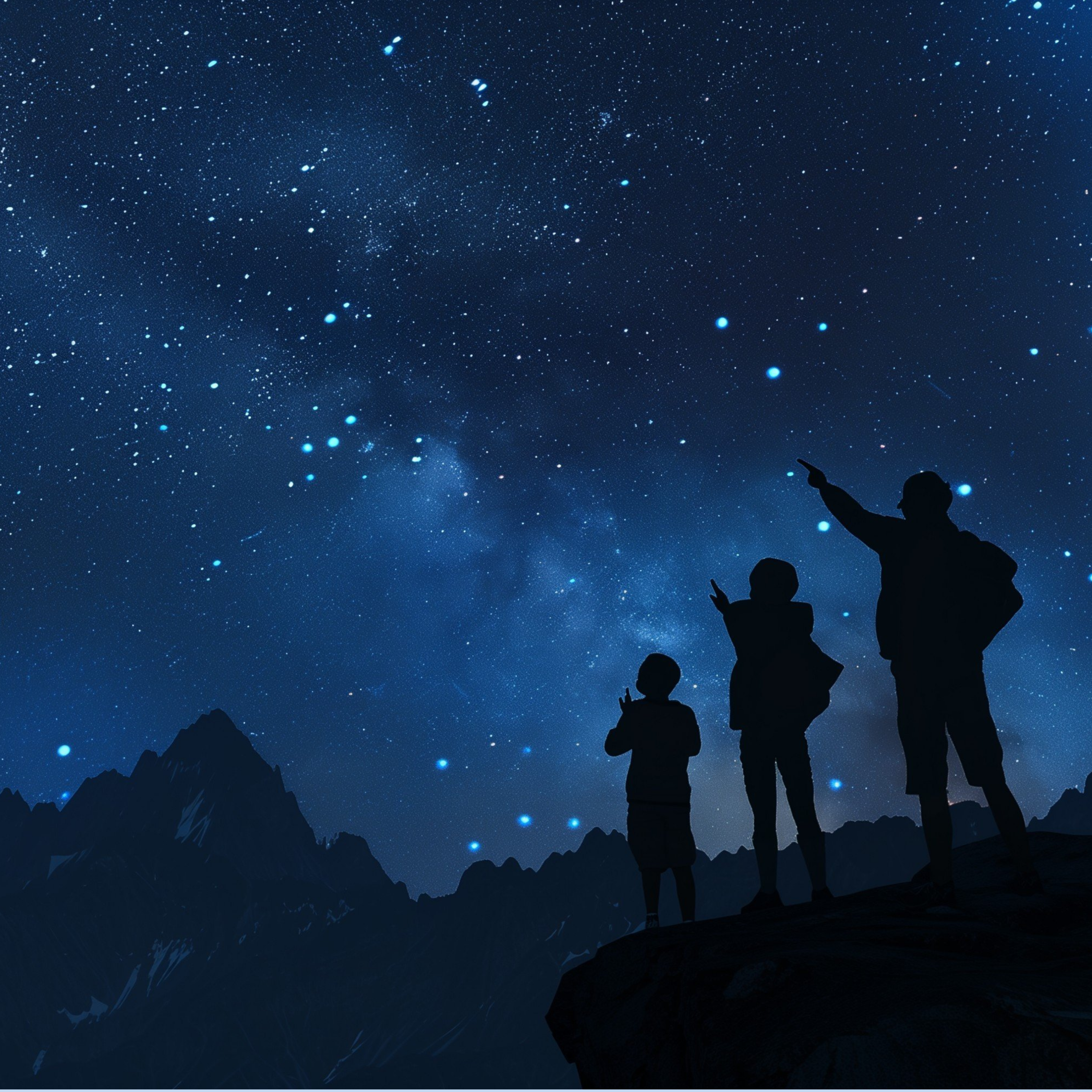
Activities with Kids: Exploring the Night Sky from Home
Looking for an activity to do with your kids that's both educational and fun? Try exploring the night sky from the comfort of your home! Done right, it can be a delightful and enriching experience. You don’t need expensive equipment or a remote location to enjoy the wonders of the night sky.
Here’s a beginner-friendly guide to some of the most fascinating celestial sights you can observe from home with your li'l ones.
1. The Moon

The Moon is our nearest celestial neighbor and is easy to spot from your backyard, balcony or terrace. Even a basic pair of binoculars can reveal craters, mountains, and valleys on the Moon’s surface. Let your kids observe the changing phases of the Moon everyday. Each phase offers a different perspective, with the waxing and waning crescent and gibbous phases highlighting different features.
2. Constellations

Constellations are patterns of stars that have been named and charted for centuries. Learning them can make the night sky feel like a familiar map.
- Orion: One of the most recognizable constellations, featuring the bright stars Betelgeuse and Rigel. Look for the three stars that form Orion’s Belt. It appears as a diagonal line when connected.
- Ursa Major: Home to the Big Dipper, this constellation is a useful guide for finding the North Star, Polaris.
- Cassiopeia: Shaped like a W, this constellation is easy to spot and helps to locate other constellations.
3. Planets
The planets in our solar system offer a dynamic show. Some are visible to the naked eye, while others may require binoculars or a small telescope.
In India, you can observe several planets throughout the year, though visibility can vary based on the specific planet and time of year.

Here’s a general guide to when and which planets are visible from India:
-
Mercury: Mercury is often challenging to spot due to its proximity to the Sun. It is best seen during its greatest elongations, which occur several times a year. These periods are when Mercury is at its greatest angular distance from the Sun, making it easier to observe just after sunset or before sunrise.
-
Venus: Venus is one of the brightest objects in the night sky and can be seen either as the "Evening Star" or the "Morning Star," depending on its position relative to Earth and the Sun. Venus typically has elongations every 19 months, and during these times, it is visible for several weeks to months.
-
Mars: Mars is usually visible in the evening or pre-dawn sky. Its visibility varies with its orbit around the Sun, but it generally appears in the evening sky for several months every 26 months or so. The best viewing times are around its opposition, when it is closest to Earth.
-
Jupiter: Jupiter is one of the most prominent planets visible from Earth. It can be seen in the night sky for several months at a time, usually rising in the evening and setting in the early morning. Its visibility peaks around opposition, which happens approximately every 13 months.
-
Saturn: Saturn is best observed when it is at opposition, which occurs roughly every 12-13 months. During this time, it is visible throughout the night. Saturn's rings make it a spectacular object to view through a telescope.
-
Uranus: Uranus is more challenging to see with the naked eye due to its dimness, but it can be observed with binoculars or a telescope. It is visible in the evening or morning sky, depending on its position relative to Earth and the Sun.
-
Neptune: Like Uranus, Neptune requires a telescope for viewing. It is visible in the night sky but can be difficult to spot due to its faintness. Its visibility changes with its orbit, and it is best viewed during its opposition.
4. Star Clusters

Star clusters are groups of stars that are physically close to each other in space and can often be seen as fuzzy patches or compact groupings of stars.
- The Pleiades (Seven Sisters): A beautiful open star cluster visible in the constellation Taurus. It appears as a small, tight group of stars. It's easily visible to the naked eye.
- The Hercules Cluster (M13): A globular cluster in the constellation Hercules, visible with binoculars as a fuzzy ball of stars!
5. Meteor Showers

Why They’re Exciting: Meteor showers are events where multiple meteors streak across the sky in a short period. They occur when Earth passes through the debris left by comets and asteroids.
The best ones seen from India are as follows:
- Perseids: They peak in August and are known for their bright and frequent meteors (100 per hour).
- Geminids: These peak in December and can produce impressive meteor displays of different colors. And you get to see around 200 per hour, if you're patient enough!
6. Zodiacal Light

Zodiacal light is a faint, diffuse glow visible in the night sky, appearing as a triangular or pyramid-shaped beam of light extending along the ecliptic plane, which is the apparent path of the Sun through the sky.
Zodiacal light is best observed during the weeks around the spring and autumn equinoxes. In India, it is most visible from late February to mid-March and from late September to mid-October. The light is most visible in areas with minimal light pollution and a clear, dark sky. Look for it in the western sky just after sunset or in the eastern sky just before dawn.
7. Noctilucent Clouds

Noctilucent clouds (NLCs) are high-altitude clouds that form in the mesosphere, above the Earth's surface. They are composed of tiny ice crystals that reflect sunlight, creating their shimmering appearance.
These clouds are typically visible during twilight hours, just after sunset or before sunrise, when the Sun is below the horizon but still illuminates the clouds from above.
8. The Milky Way

The Milky Way is our galaxy, and seeing its band of light stretching across the night sky can be awe-inspiring. It is best viewed from a location away from city lights, though you can still catch glimpses from suburban areas. Look for a hazy, cloudy band of light that spans across the sky.
Tips for Skywatching from Home:

Find a Dark Spot: Even in suburban areas, try to find a spot away from streetlights and city glare.
Use a Star Map or App: There are many apps available that can help you identify stars, planets, and constellations. We recommend Stellarium!
Be Patient: Allow your eyes to adjust to the darkness for the best viewing experience. This can take about 20 minutes.
Keep a Journal: Let your kids note down observations and the dates when you saw certain objects. This can help you track changes and improve your stargazing skills.
With these tips and targets, you’ll be well on your way to enjoying the night sky right from the comfort of your home. Happy stargazing!



